Abraham's Birthplace and Time
When and Where?
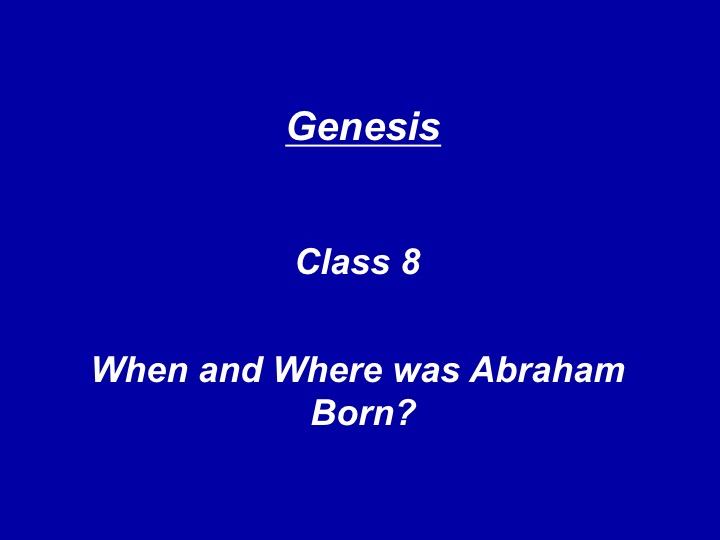
Let's have a little fun today examining a couple of questions that have vexed biblical scholars for years. We are going to discuss
the two questions announced by this title. I want to emphasize before we start
this that neither of these questions is critical to church tradition, church
doctrine, church theology, or beliefs.
But both questions vex scholars a great deal because inquiring minds
want to know. So there has been much scholarly debate over the years. We are
not going to answer either question today in a definitive way – because I don’t
have a clue who is right in these debates.
But if you are interested in things biblical as I am it is interesting
to examine the different ways scholars have approached these questions. In the end you can decide for yourself if you
are interested. But as we say in East Texas - I don’t have a dog in this hunt.
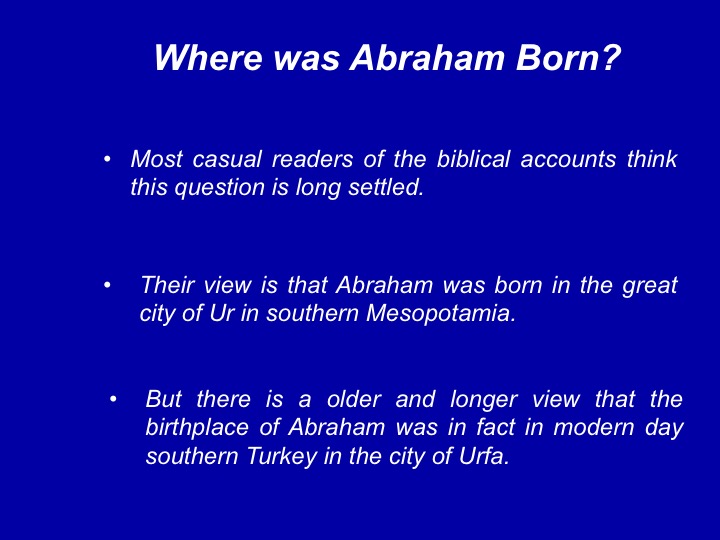
Most casual readers of the biblical accounts think this question is long settled.
Their view is that the Abraham birthplace was in the great city of Ur in southern Mesopotamia.
But there is and older and longer view that the birthplace of Abraham was in fact in modern day southern Turkey in the city of Urfa.
Both sides in this argument have used careful readings of Genesis to try to support their views.
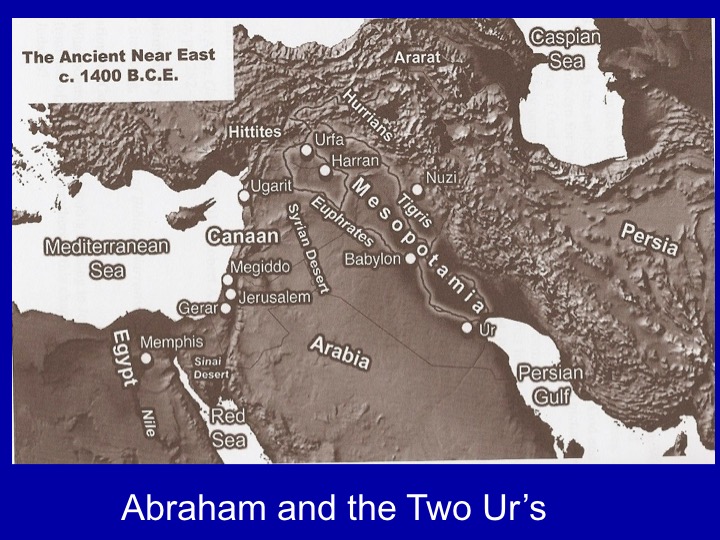
To better understand what we are talking about let’s look at a map of the ancient near east as it was conceived in 1400 B.C.
Here is Egypt in the west – the Land of Canaan – the Syrian desert and then the great river systems of Mesopotamia – the Tigris and the Euphrates.
I want to point out that this is quite different from a modern map. In the intervening 300 centuries the top end of the Persian Gulf has filled up with silt and the location of Ur is no longer on the water and is in a desert area.
The two cities we are talking about are Ur – here at the end of the Euphrates River, and way up on the other end the city of Urfa. So let’s start explaining why so many people believe the southern Ur is the birthplace of Abraham.
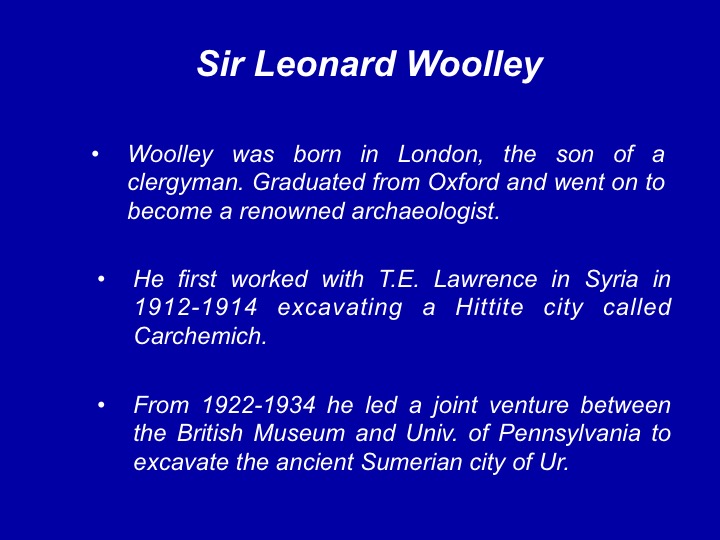
To understand this we need to meet Sir Leonard Woolley.
Woolley was born in London, the son of a clergyman. Graduated from Oxford and went on to become a renowned archaeologist.
He first worked with T.E. Lawrence in Syria in 1912-1914 excavating a Hittite city called Carchemich.
From 1922-1934 he led a joint venture between the British Museum and Univ. of Pennsylvania to excavate the ancient Sumerian city of Ur.
Now before Woolley made his discoveries there was a fairly low understanding of the grandeur of Ur. It was known that the most ancient civilization was the Sumerians in the southern part of Mesopotamia but no significant discoveries had been made.
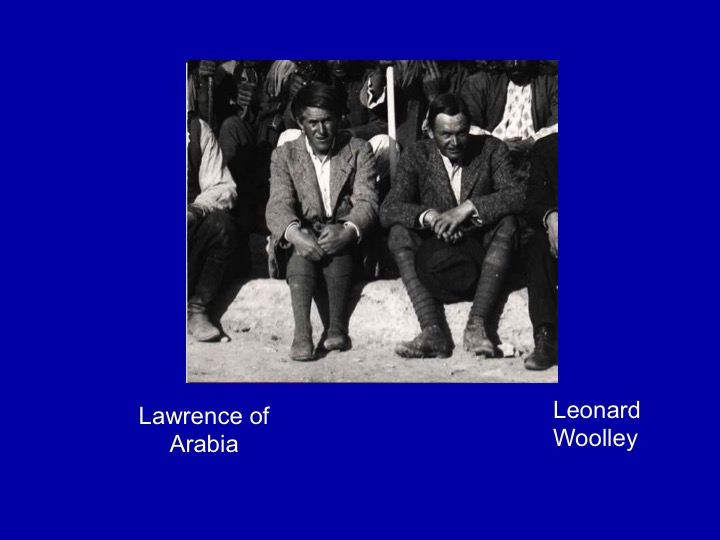
This was the only picture I
found of Woolley. This is on his first
excavation that he did in partnership with T.E. Lawrence.
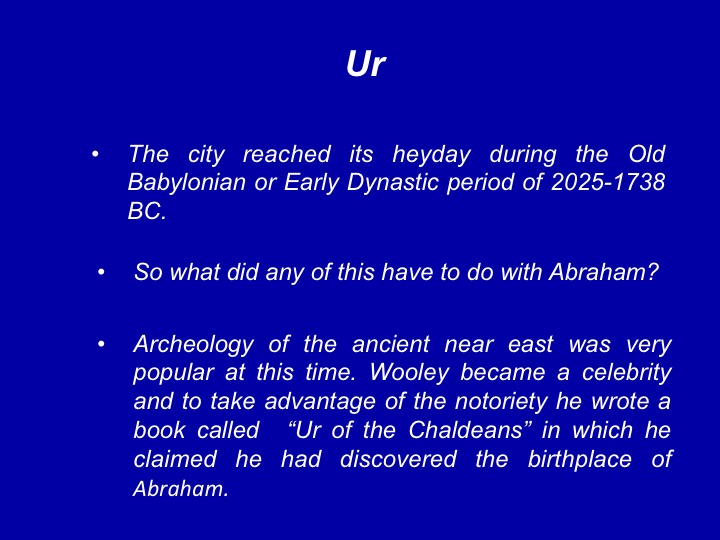
The city reached its heyday during the Old Babylonian or Early Dynastic period of 2025-1738 BC.
Four main residential areas of the city included homes with baked mud brick foundations arranged along long, narrow winding streets and alleyways. Typical houses included an open central courtyard with two or more main living rooms in which the families resided. Each house had a domestic chapel where cult structures and the family burial-vault was kept. Kitchens, stairways, workrooms, lavatories were all part of the household structures.
The houses were packed in very tightly, with exterior walls of one household immediately abutting the next one. Although the cities appear very closed off, the interior courtyards and wide streets provided light, and the close-set houses protected the exposure of the exterior walls to heating especially during the hot summers.
Important discoveries at Ur included the Royal Cemetery, where rich Early Dynastic burials were found by Woolley in the 1920s; and thousands of clay tablets impressed with cuneiform writing which describe in detail the lives and thoughts of Ur's inhabitants.
So what does any of this have to do with Abraham?
Archeology of the ancient near east was very popular at this time. Woolley became a celebrity and to take advantage of the notoriety he wrote a book called “Ur of the Chaldeans” in which he claimed he had discovered the birthplace of Abraham.
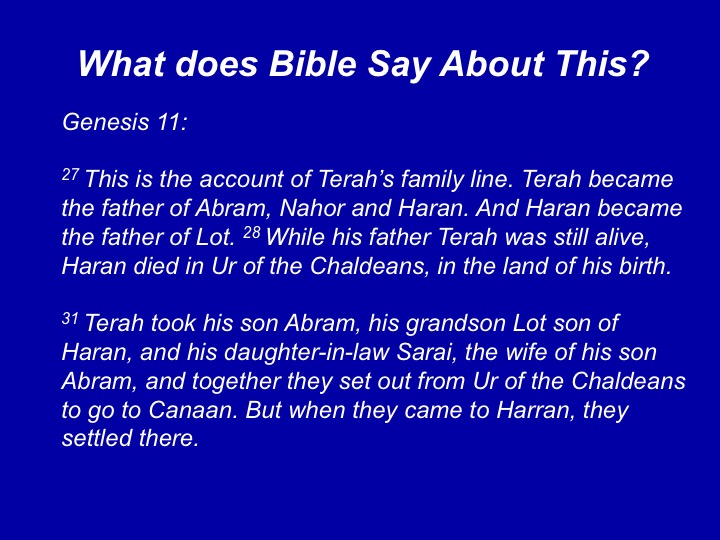
A scholarly linguistic issue arises here.
The original Hebrew text reads those verses we just saw as Ur-kasdim
And all of the early English translations (Wycliff, Tyndale, KJV, Geneva, etc.) have rendered this as either Ur of the Chaldeans or Ur of the Chaldees.
And interestingly a group of Semitic people called the Chaldeans immigrated into this part of Southern Mesopotamia – although that was not until the eighth century BC.
But linguistically this could be rendered also as the Chaldoi, and that is also a proper translation based on what we know of the language. What is the significance of that? The Chaldoi were a people that the Greek historian Xenophon identifies as neighbors of the Armenians in northern Mesopotamia. So Ur-Kasdim could be translated either way.
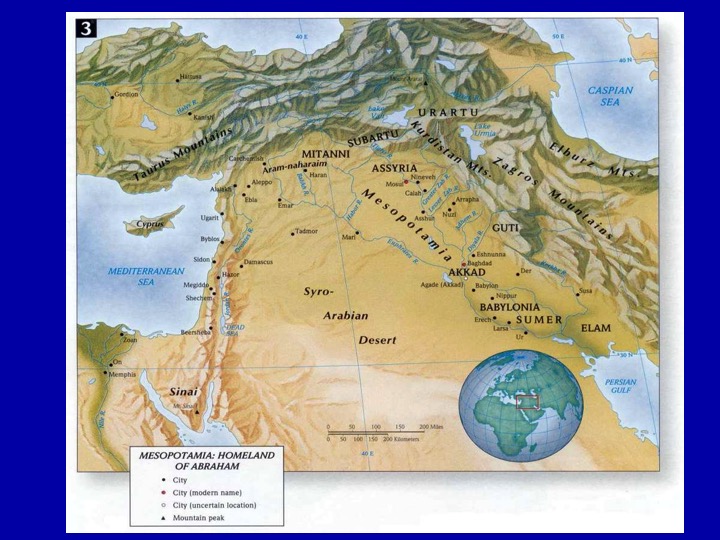
So let’s review a map again. The two conflicting hypothesis are for Ur – the great Sumerian city at the very end of the Euphrates river and Urfa in far northern Mesopotamia.
I will now present some other biblical evidence in support of the city of Urfa.
In Joshua 24 Joshua states that God had proclaimed Abraham lived beyond the Euphrates and that God had brought him across the Euphrates to the Land of Canaan. But as you can see that does not work for Ur which is on this side or the western side of the Euphrates. Urfa, on the other hand is clearly beyond the Euphrates.
And if we read the episodes in Genesis 24 and 29, when people from Abraham's inner circle (his servant and his grandson Jacob, respectively) return to the family homeland, they journey to the region of Aram Nahariam, that is, northern Mesopotamia.
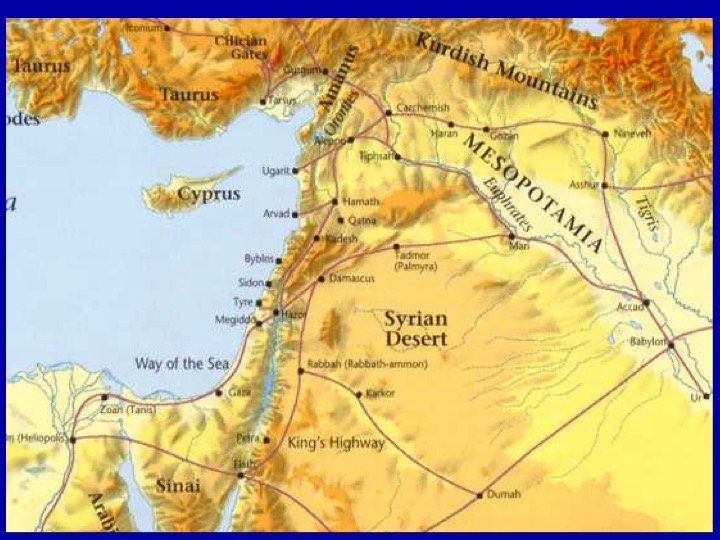
And suddenly – a possible breakthrough.
And to me – a rather telling point in favor of Urfa is that in Genesis 11 that we just read earlier the text describes that:
Genesis 11 Terah took his son Abram, his grandson Lot son of Haran, and his daughter-in-law Sarai, the wife of his son Abram, and together they set out from Ur of the Chaldeans to go to Canaan. But when they came to Harran, they settled there.
So Terah left Ur of the Chaldeans to go to Canaan but when they came to Haran they decided to stay and settle there. But as shown on this map that we examined several weeks ago when we studied the Ancient Near East – anyone traveling from the southern Ur on the way to Canaan would not have gone all the way to Haran and then came all the way back – because the predominant route from Babylon to Canaan was the route called the ‘Way of the Sea”. The section from Damascus to Mari was also called the Great Trunk Road”. And was considered the safest route between Babylon to Canaan and Egypt.
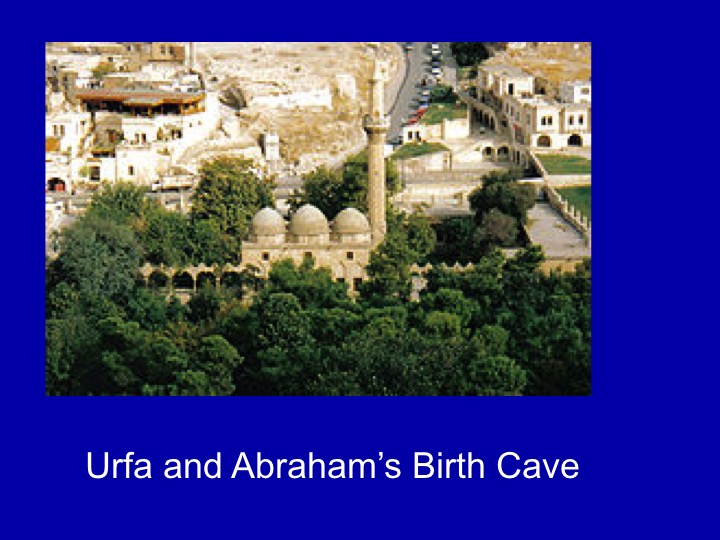
This is a picture taken from
a hill of the Islamic Mosque in Urfa which straddles a cave said to be the
birthplace of Abraham.
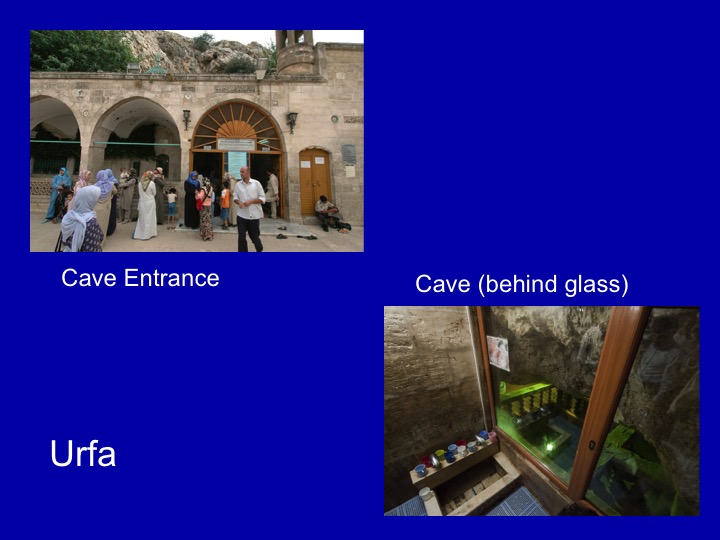
This in Urfa – in southern Turkey. The entrance to the cave of Abraham’s purported birthplace is shown here with pilgrims visiting.
And the cave itself is behind the glass here.
And so you have the two competing cities. I should mention that some Iranians believe the Abraham birthplace was in Iran – but I am not as familiar with that claim. So we report – you decide. Any comments or questions on this before we move to the next Abraham question?
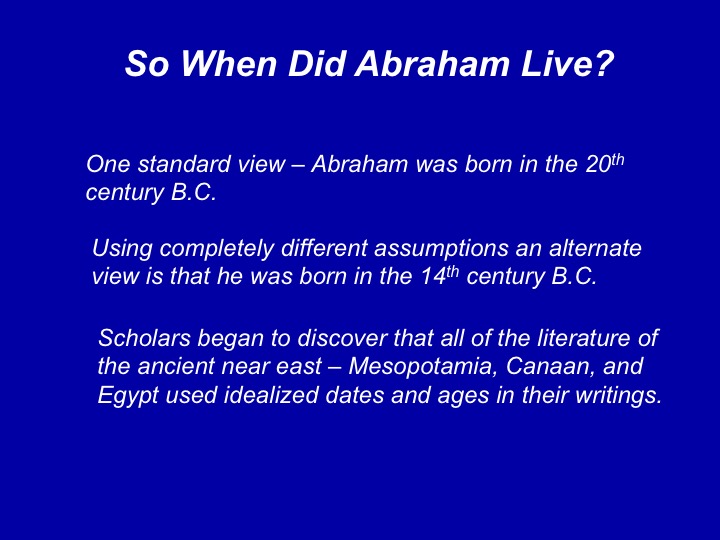
So when did Abraham live? This one is really tricky. A standard view places Abraham as early as 2000 B.C. This dating typically is based on a literal acceptance of the number of years presented in the Bible, which has come into question in the 20th century because of all of the literary discoveries of the writing style of that early period.
There is a competing view however – one based not on literal acceptance of all of the ages and time periods presented– but on the genealogical records presented in Genesis. And as it turns out that gives a completely different number. Using that approach Abraham can be dated as early as the 14th century B.C.
Again – this dating is not threatening to anyone's beliefs – but again – inquiring minds want to know – and so they argue.
Scholars began to discover that all of the literature of the ancient near east – Mesopotamia, Canaan, and Egypt - used idealized dates and ages in their writings. And the further back you go the more idealized it becomes.
Some silly examples – one ancient Mesopotamian King (before Gilgamesh) was purported to live 65,000 years. That is definitely an extreme – but what scholars found in general was that when ancient near east writers wrote about their hero's of old they always depicted their most important leaders as living extremely long lives. If they died at a normal age they could not have been important. This is a literary convention – it had nothing to do with accurate reporting of ages – because in fact peoples in those cultures did not keep track of their ages. This is something that westerners have a very hard time understanding.
Let me illustrate by relating a story told by Cyrus Gordon– a famous early 20th century ancient near east scholar and a specialist in ancient language.
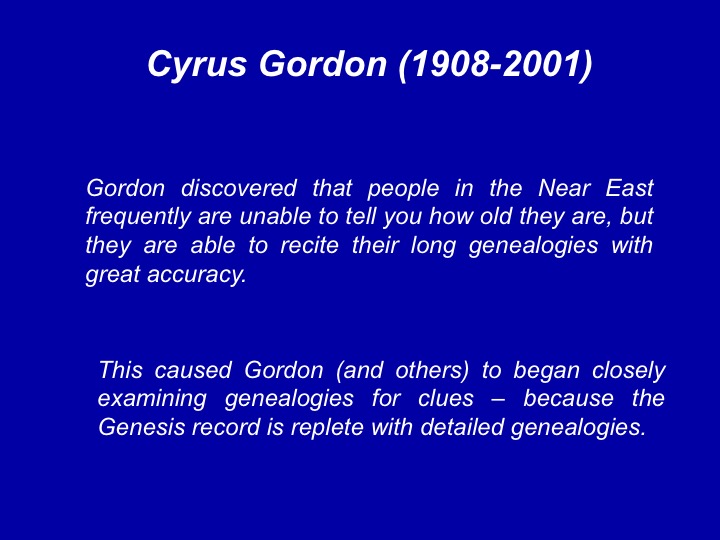
So here is the story – which I will relate but not show on the slide. Gordon, who was raised in an upper class Jewish family, got his PhD in linguistics and Hebrew studies at the University of Pennsylvania and went on an archeological dig in northern Iraq after graduating.
Gordon discovered that people in the Near East frequently are unable to tell you how old they are, but they are able to recite their long genealogies with great accuracy.
So here is his story, which he has written about to illustrate his realization of this phenomena. I am just going to tell it rather than show it on a slide.
On a particular dig Gordon notice a father-son team working together doing the hard work of excavating and recovering artifacts from the digs and he was very impressed with the young boy, who seemed to him to be about 10-11 years old.
At a lunch break one day Gordon sat down next to the father of the boy and decided to try out his language skills with the man. He complimented the man about his son and told him he should be proud of having a boy who worked so diligently and carefully on this type of work. The man was very pleased that Gordon noticed and responded that he was indeed very proud of his son.
Gordon then asked an innocent question - "How old is your son"? The reply - "Oh - only Allah knows - maybe 20 maybe 40." Gordon was shocked at the answer and that night among the experienced British and American archeologists he was working with on his first dig repeated the story. The other archeologists all laughed and said "Didn't you know? No one in these cultures knows their age. "They don't know their birthday year, and they don't count birthdates."
So the next day Gordon made a point of sitting by the father again and gradually worked another question into the conversation - "How old are you?
The answer. "Only Allah knows - maybe 40, maybe 80." And then Gordon discovered that the man could recited his ancestors back for hundreds of years.
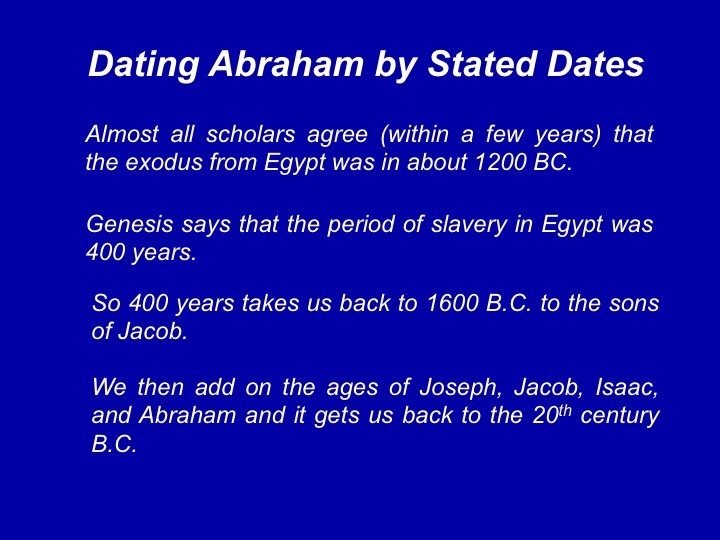
So let’s talk about the two very different approaches for dating Abraham.
The math is pretty simple.
Almost all scholars agree (within a few years) that the exodus from Egypt was in about 1200 BC.
Genesis says that the period of slavery in Egypt was 400 years.
So 400 years takes us back to 1600 B.C. to the sons of Jacob.
We then add on the ages of Joseph, Jacob, Isaac, and Abraham and it gets us back to the 20th century B.C.
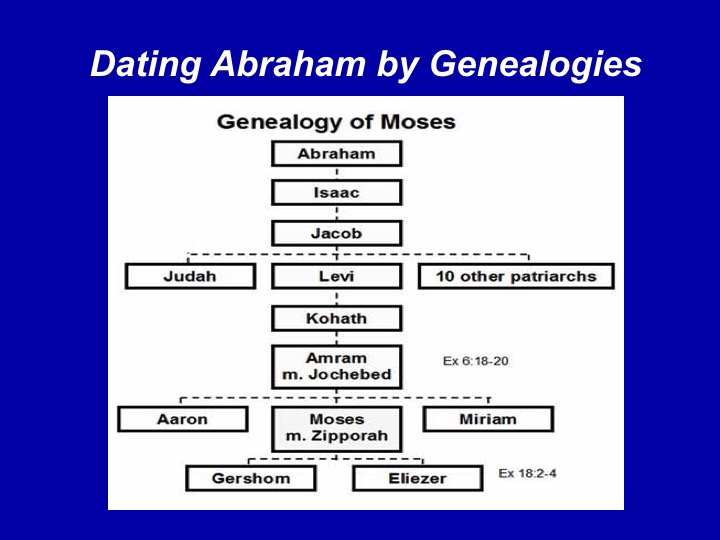
So the other extreme is to ignore the ages and accept the genealogies literally.
The genealogy presented in Exodus 6: 18-20 shows that after Jacob died in Egypt there were 4 generations until they left Egypt with Moses. And so people who want to date Abraham by this data state that a generation has always been about 24-32 years throughout history so the period spent in captivity could only have been about a century – not 400 years. Then there is only another 4 generations back to Abraham so that’s another century so we are back to the 14th century B.C.

Does the fact that smart people analyzing these numbers come up with completely different views of when Abraham lived.
My simple answer is no.
But you may object that shouldn’t these genealogies and the ages of the Patriarchs give us exactly the same numbers or the Bible cannot be trusted.
But I will repeat something I said in week one – the biggest mistake modern readers make is to try to read our 20th century world views back into ancient literature. By trying to literally interpret either the ages or the genealogies we are assuming that the ancient world was trying to present or understand this information scientifically or literally – when in fact I think they were trying to present all of this narrative in a very sacred way. And in the ancient world of Mesopotamia, Canaan, and even Egypt, as we will see in a couple of weeks – everything was sacred – including (especially) numbers. And both the readers and the writers wanted to those numbers to be perfect in an idealized or sacred way – which is not the way we think today.
But figuring all of that out is not easy – because
we unfortunately do not see the world in nearly a sacred way as the ancients
did. So we have to keep working on it to try to figure it out.

So far I have teased you a little on some of the
special aspects of Genesis as literature – things like the chiastic structure I
showed of the flood story. But there is
much more that I want to tell you about and we are going to devote the next class
to appreciating the great literary skill of the author(s) of Genesis.